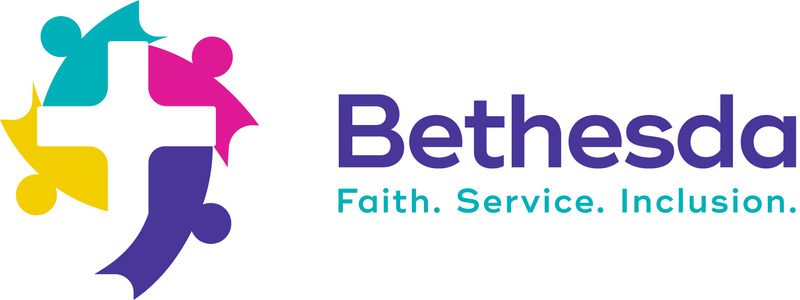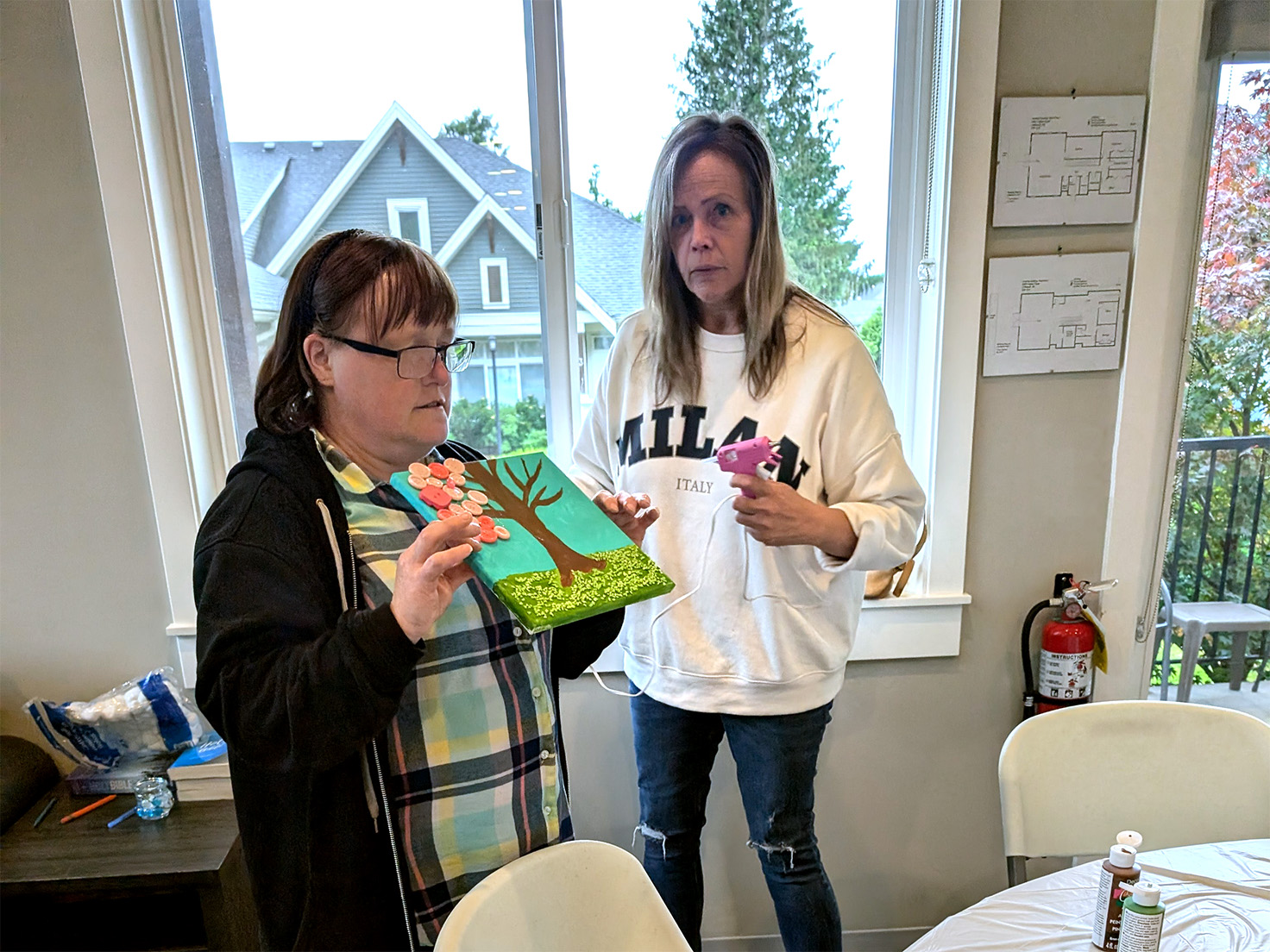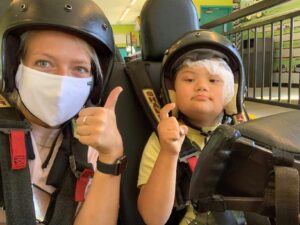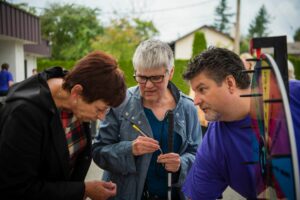Joanne stands in front of the six peers who have turned up for tonight’s art club class. She’s holding a 10″ x 12” multi-media painting of a tree exploding with colourful, button blossoms. She has chosen this project for her peers Stephen, Jacquie, Isaac, Andy, Arlene and Amber to do this evening. Over the next 1½ hours she will guide them through the project, explaining the materials they will be using: buttons, cotton puffs, pebbles, paint and glue; and the steps involved. She leads with simple and clear instructions which inspires confidence as each artist picks up their white canvas board.
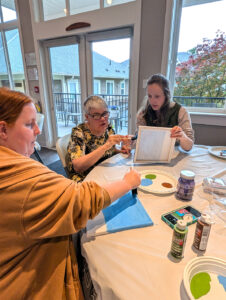
Amber and Arlene fill in the sky on their paintings.
She’s advised the group to start painting the sky first. They take up their brushes. Diverse abilities such as impaired eyesight or limited fine motor skills are not a barrier in this club. Support workers are there for anyone who needs assistance.
The white canvases fill up with colour as the background of the sky and ground are painted. While the artists wait for the paint to dry, Joanne goes over the next step: painting the shape of the tree. She shows people her model as an example, but encourages everyone to paint a tree shape that pleases them. As the designs take shape it becomes clear that each person has their own vision about what their tree will look like. The differences are refreshing and inspire curiosity about what the final results will look like.
Joanne walks around to see how each person is doing. She encourages her students, ‘Andy, that’s really good’ or ‘Nice job on the tree’. Stephen drew a tree shape with branches but didn’t fill in the trunk with paint. When Elan asked if he was going to paint the inside, he thought for a brief moment and said, ‘No’. Might he be creating a bush rather than a tree? As Elan says, “Each person feels free to express themselves. We don’t teach there is a wrong way.” Each person is encouraged to see that by creating something unique, while it may look unusual at the beginning, by the time the piece is finished, it is captivating. It reveals the marvel of each person’s imagination and free will.
Now for the texture. Joanne shows them how to apply the ‘grass’. “First, we’ll smear the glue over the ground – the green part in the picture – and then, like, put some of the rocks in our hand and kind of spread it over the glue. But not so thick that it falls off.” The artists pick up the glue bottles and pour the purple, syrup-like contents onto their canvases. Some scatter the gravel thickly and evenly, some in patches. They leave their boards to let the gravel set in the glue.
As they wait, they check out each other’s paintings. Lots of admiration and approval. A few tips are given about how much gravel to apply… “Oh, maybe use more glue so you have a nice thick layer to trap the gravel particles.” The layer of texture adds dimension and interest to the painting.
As the final step, foliage is added to the tree. As in real life, leaves and blossoms are what draw our eye to the magnificence of trees. In this project, each artist will use buttons to represent leaves or blossoms. Joanne, in shopping for the project, found as many colours as she could at the local dollar store: shades of purple, pink, red, green, white and in a variety of sizes and textures.
For this stage, Joanne demonstrates how to use the glue gun to apply hot glue to each button and then place it on the tree. She encourages people to think about the different colours, textures and shapes of the buttons to decorate their tree. Some pick the purple buttons, others are fans of the multi-colour look. Arlene’s tree is filling out with buttons, but there are a few spaces. With her visual impairment, she feels around for the tiniest buttons and Sarah her support worker helps her to apply the glue and place them in the gaps. Amber, who is sitting beside her, takes an interest and joins in the search for small buttons.
At the end of the class, each person has a painting they are proud of, and Joanne feels a sense of accomplishment. She shares, “I was a little nervous at the beginning, unsure of what I was going to say or do.” Despite her initial uncertainty, Joanne had the full attention of the participants, earning their trust to guide them through the creative process and inspiring confidence in their own choices. Judging by the stunning artistic results, her leadership was exceptional.
Each 3rd week of the month, people of all abilities come together at Vedder Terrace to do art. Started as an idea by Elan, a support worker from Collins Home, it has become a much looked-forward to activity. They create their own vision of a project. Each class is led by a self-advocate who volunteers to lead the group on a project, showing the participants techniques, and helping them to complete their creations. The participants feel satisfaction with their finished art and display them proudly. The instructors feel valued and the experience of overcoming any nervousness to lead their peers is strengthening. With each month, the art club grows, interest from other resources grows, and self-advocates feel emboldened to lead.
